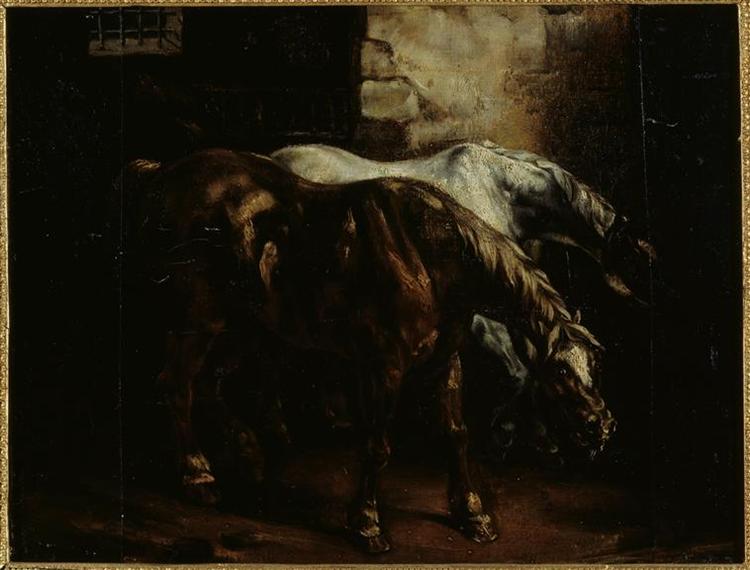Description
In the work "Two posta horses" by Théodore Géricault, the viewer is received by a powerful and evocative representation of force and movement. Painted around 1817, this work is part of the period of romanticism, a movement that advocates the emotion, nature and individuality, contrasting with the rigidities of neoclassicism that preceded it. Géricult, acclaimed by his ability to capture human anguish and the sublime greatness of the elements, achieves in this piece a portrait of horses that transcends the merely representational to explore issues of dynamism and vitality.
The composition is dominated by the image of two horses that are energetic and almost moving. Animals, represented with a detailed anatomical treatment, acquire almost heroic importance, suggesting both their usefulness and strength. Géricault captures the musculature, energy and the vine of these horses with precision that reflects their deep knowledge of the equine world, something that is also evident in other works of the artist, such as "The Balsa of the Medusa." The disposition of horses, one slightly behind the other, suggests the idea of speed and agility, evoking the image of an imminent action context, whether a trip or a competition.
The use of color in "two posta horses" is equally remarkable. Géricault uses an earthly palette, in which brown and ocher tones predominate, allowing horses to highlight strongly against the bottom. This chromatic choice not only provides a sense of realism, but also establishes a dialogue with the natural environment that surrounds animals. The light that affects horses highlights its characteristics, creating a three -dimensionality effect that allows the viewer to almost feel the texture of their skin and the power of their energy.
Another aspect that stands out in this work is the artist's decision not to include human characters. When focusing exclusively on horses, Géricault invites the viewer to contemplate the noble character of these animals, as well as to reflect on their relationship with man and his role in society. In a context where technology began to gradually replace the use of animals in transport and work, horses are presented here not only as loading animals, but as majestic beings that deserve admiration.
Géricult, through "two post -post horses," stands as a pioneer in the portrait of nature and its creatures, offering a vision that goes beyond the superficial. His ability to evoke emotions through precise and vigorous representation not only highlights his technical skill, but also establishes a visual story that explores the beauty of the beast and its importance in human life. This work is part of a broader tradition in the art of animal representation, where artists such as George Stubbs and Rosa Bonheur also explored the relationship between man and animal kingdom with an equally respectful approach.
In summary, "two posta horses" by Théodore Géricault is a work that encapsulates the spirit of romanticism through its intense representation of the animal force and its technical mastery. With his focus on equine anatomy and his powerful palette, Géricult not only pays tribute to these noble animals, but also offers a meditation on the connection between humanity and nature, in a moment of social and technological change. This painting, although less known than some of his masterpieces, deserves a prominent place in the study of romantic painting and in art history.
KUADROS ©, a famous paint on your wall.
Hand-made oil painting reproductions, with the quality of professional artists and the distinctive seal of KUADROS ©.
Reproduction service paintings With a guarantee of satisfaction. If you are not completely satisfied with the replica of your painting, we refund your money 100%.

